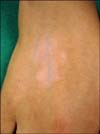Abstract
As the usage of biologics for rheumatic diseases increases, such as rheumatoid arthritis and ankylosing spondylitis, various cutaneous adverse events are also being increasingly reported. We experienced a case of development of vitiligo during a TNF-α antagonist therapy in a 22-year-old woman with rheumatoid arthritis. The patient was presented with vitiligo lesions on the dorsum of both hands after 1 month of treatment with etanercept. Vitiligo improved with topical tacrolimus ointment and excimer laser treatment without the discontinuation of etanercept. No clearly defined mechanism for vitiligo induced by TNF-α antagonist exits. However, considering that vitiligo is an autoimmune disorder, the development of this skin lesion in association with the TNF-α antagonist could be explained by a paradoxical induction of the autoimmune process.
Figures and Tables
References
1. Choy EH, Panayi GS. Cytokine pathways and joint inflammation in rheumatoid arthritis. N Engl J Med. 2001. 344:907–916.
2. Moustou AE, Matekovits A, Dessinioti C, Antoniou C, Sfikakis PP, Stratigos AJ. Cutaneous side effects of anti-tumor necrosis factor biologic therapy: a clinical review. J Am Acad Dermatol. 2009. 61:486–504.
3. Borrás-Blasco J, Navarro-Ruiz A, Borrás C, Casterá E. Adverse cutaneous reactions induced by TNF-alpha antagonist therapy. South Med J. 2009. 102:1133–1140.
4. Ismail WA, Al-Enzy SA, Alsurayei SA, Ismail AE. Vitiligo in a patient receiving infliximab for refractory ulcerative colitis. Arab J Gastroenterol. 2011. 12:109–111.
5. Lahita RG, Vernace MA. Vasculitis, vitiligo, thyroiditis, and altered hormone levels after anti-tumor necrosis factor therapy. J Rheumatol. 2011. 38:579–580.
6. Ramírez-Hernández M, Marras C, Martínez-Escribano JA. Infliximab-induced vitiligo. Dermatology. 2005. 210:79–80.
7. Exarchou SA, Voulgari PV, Markatseli TE, Zioga A, Drosos AA. Immune-mediated skin lesions in patients treated with anti-tumour necrosis factor alpha inhibitors. Scand J Rheumatol. 2009. 38:328–331.
8. Bolognia JL, Pawelek JM. Biology of hypopigmentation. J Am Acad Dermatol. 1988. 19:217–255.
9. Nordlund JJ, Lerner AB. Vitiligo. It is important. Arch Dermatol. 1982. 118:5–8.
10. Hann SK. Immunology of Vitiligo. Korean J Dermatol. 1995. 33:801–814.
11. Ramos-Casals M, Roberto-Perez-Alvarez , Diaz-Lagares C, Cuadrado MJ, Khamashta MA. BIOGEAS Study Group. Autoimmune diseases induced by biological agents: a double-edged sword? Autoimmun Rev. 2010. 9:188–193.
12. Williams VL, Cohen PR. TNF alpha antagonist-induced lupus-like syndrome: report and review of the literature with implications for treatment with alternative TNF alpha antagonists. Int J Dermatol. 2011. 50:619–625.
13. Lv Y, Li Q, Wang L, Gao T. Use of anti-tumor necrosis factor agents: a possible therapy for vitiligo. Med Hypotheses. 2009. 72:546–547.
14. Oh JM, Koh EM, Kim H, Lee J, Ahn JK, Cha HS, et al. Exacerbation of psoriatic skin lesion followed by TNF-alpha antagonist treatment. J Korean Rheum Assoc. 2010. 17:200–204.
15. Jwa YJ, Kim NH, Park HJ, Park JS, Bae WK, Kim KA, et al. A case of psoriasis induced by infliximab treatment for Crohn's disease. Korean J Gastroenterol. 2010. 56:324–328.




 PDF
PDF ePub
ePub Citation
Citation Print
Print





 XML Download
XML Download